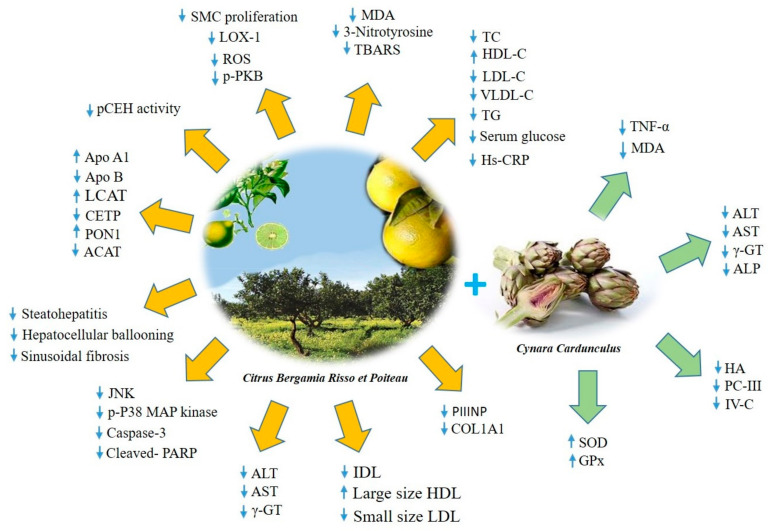Figure 2.
The molecular mechanisms involved in the beneficial effects of bergamot polyphenols. ACAT, Acetyl-Coenzyme A Acetyltransferase; ALP, Alkaline Phosphatase; ALT, Alanine Aminotransferase; Apo A1, Apolipoprotein A1; Apo B, Apolipoprotein B; AST, Aspartate Aminotransferase; CETP: Cholesteryl Ester Transfer Protein; COL1A1, Pro-Collagen type I; GPx, Glutathione Peroxidase; HA, hyaluronic acid; HDL-C, High Density Lipoprotein Cholesterol; Hs-CRP, High-sensitivity C-Reactive Protein; IDL, Intermediate Density Lipoprotein; JNK, c-Jun N-terminal Kinase; LCAT, Lecithin Cholesterol Acyltransferase; LDL-C, Low Density Lipoprotein Cholesterol; LOX-1, Lectin-type Oxidized LDL receptor 1; MDA, Malonildialdehyde; PARP, Poly(ADP-ribose) Polymerase; pCEH, pancreatic Cholesterol Ester Hydrolase; PC III, Pre-collagen type III; p-PKB, phospho- Protein Kinase B; PON1, Paraxonoase-1; PIIINP, Pro-Collagen III N-terminal propeptide; ROS, Reactive Oxygen Species; SMC, Smooth Muscle Cell; SOD, Superoxide Dismutase; TBARS, Thiobarbituric Acid Reactive Substances; TC, total Cholesterol; TG, Triglycerides; TNF-α, Tumor Necrosis Factor-alpha; VLDL-C, Very-Low-Density Lipoprotein Cholesterol; γ-GT, Gamma-Glutamyl Transferase; IV-C, Collagen type IV.

